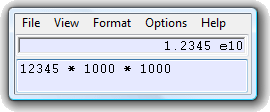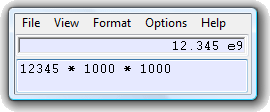- Precision can be set to 8, 12, or 16 digits, or be automatic.
- Optionally show digits in groups of 3 or 5 for easy reading.
- Normal, scientific and engineering formats.
- View as hexadecimal
In the normal mode, numbers in the range from 0.001 to just under 10000000000 (or 1010) are shown in the usual manner. When numbers become very large or very small, a 'scientific' format is more useful. So, for example, a number such as 1.23 x 1050 is shown as 1.23e50. You can choose when UltimaCalc should switch to showing numbers in scientific format, or you can have this on all the time, and optionally have the exponent always shown as a multiple of 3.

In the 'Scientific 1' format, numbers are always shown in scientific format, regardless of their value. There is always a single (non-zero) digit before the decimal point. This is illustrated by the image on the right, which also shows that the window's caption can be hidden, for the sake of compactness. (The window can still be dragged, by clicking on the area to the right of the menus.)
The other 'scientific' format, 'Scientific 3' uses a similar format, but the number shown as the exponent is always a multiple of 3. In this format, there can be 1, 2 or 3 digits before the decimal point, depending on the value.

When the precision is set to automatic, the number of digits displayed depends on the width of the window. As many as possible are displayed, up to a maximum of 36, and allowing room for a leading minus sign even if the number is non-negative. UltimaCalc performs calculations at maximum precision regardless of that used for display purposes.
With a very wide window, a long string of digits is displayed. To make these easier to read, they can be shown in groups of three or five digits. Even so, it is often more convenient to display results with fewer digits. You can choose to have only 8 digits, or 12, or 16 displayed. Regardless of the way in which results are displayed, they are always stored internally to their full precision.
Here are some examples illustrating how the result of calculating 8000000/81 is shown in various formats:
| Normal (16 digits) | 98765.43209876543 |
| Normal, groups of 3 digits | 98 765.432 098 765 43 |
| Normal, groups of 5 digits | 98765.43209 87654 3 |
| Scientific 1 (12 digit precision, ungrouped) | 9.87654320988 e4 |
| Scientific 3 (exponent is always a multiple of 3) | 98.7654320988 e3 |
| Engineering (8 digit precision) | 98.765432 k |